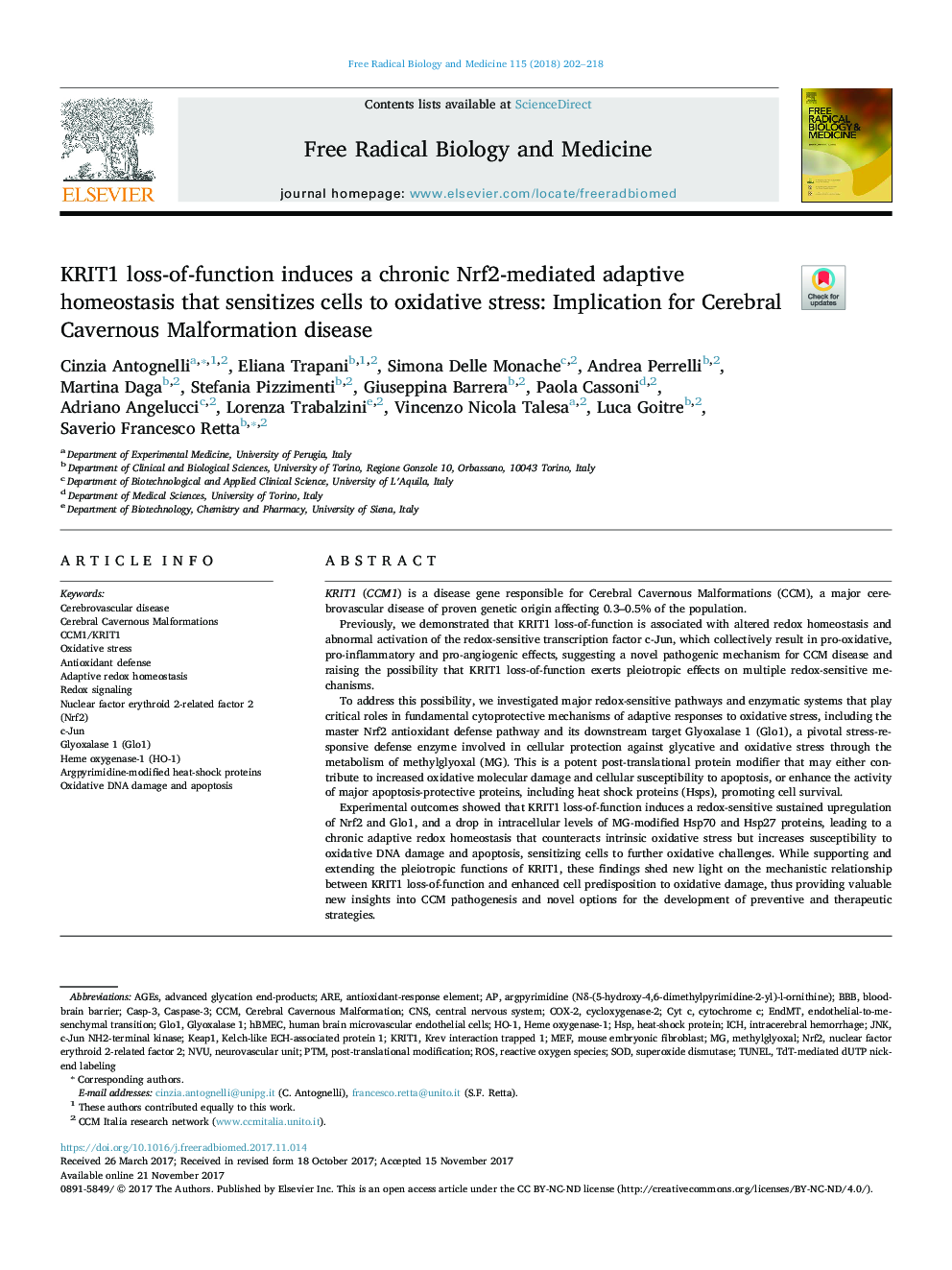| کد مقاله | کد نشریه | سال انتشار | مقاله انگلیسی | نسخه تمام متن |
|---|---|---|---|---|
| 8266201 | 1534927 | 2018 | 17 صفحه PDF | دانلود رایگان |
عنوان انگلیسی مقاله ISI
KRIT1 loss-of-function induces a chronic Nrf2-mediated adaptive homeostasis that sensitizes cells to oxidative stress: Implication for Cerebral Cavernous Malformation disease
دانلود مقاله + سفارش ترجمه
دانلود مقاله ISI انگلیسی
رایگان برای ایرانیان
کلمات کلیدی
HBMECcycloxygenase-2AGEsHspCOX-2GLO1HO-1Cyt CNrf2EndMTMEFNVUHeme oxygenase-1c-Jun NH2-terminal kinaseJnkKRIT1PTMHeme Oxygenase-1 (HO-1)keap1 - buy1CCm - CCMROS - ROSpost-translational modification - اصلاح post-translationalEndothelial-to-mesenchymal transition - انتقال Endothelial-to-mesenchymalCasp-3 - بوش 3Cerebrovascular disease - بیماری عروق مغزیTdT-mediated dUTP nick-end labeling - تلگراف نامحدود DUTP تدوین شده توسط TdTOxidative stress - تنش اکسیداتیوTUNEL - تونلc-Jun - جون ژوئنintracerebral hemorrhage - خونریزی داخل مغزیCNS - دستگاه عصبی مرکزیAntioxidant defense - دفاع آنتی اکسیدانSOD - سدBBB - سد خونی مغزیHuman brain microvascular endothelial cells - سلول های اندوتلیال میکرو عروقی مغز انسانSuperoxide dismutase - سوکسوکس دیسموتازcytochrome c - سیتوکروم سیcentral nervous system - سیستم عصبی مرکزیRedox signaling - سیگنالینگ RedoxNuclear factor erythroid 2-related factor 2 (Nrf2) - عامل فاکتور هسته ای اریتروتیک 2 مرتبط 2 (Nrf2)antioxidant-response element - عنصر پاسخ آنتی اکسیدانیnuclear factor erythroid 2-related factor 2 - فاکتور هسته ای عامل erythroid 2 مرتبط 2Blood-brain barrier - مانع خون مغزیMethylglyoxal - متیل گلی اکسالadvanced glycation end-products - محصولات نهایی گلیسایی پیشرفتهICH - منmouse embryonic fibroblast - موش فیبروبلاست جنینیCerebral cavernous malformation - ناهنجاری مغزی مغزیCerebral cavernous malformations - ناهنجاری های مغزی مغزیARE - هستندneurovascular unit - واحد عصبی عضلانیKelch-like ECH-associated protein 1 - پروتئین مرتبط با ECH کلچ 1heat-shock protein - پروتئین گرمایی شوکCaspase-3 - کاسپاز ۳ Glyoxalase 1 - گلیوکسیلاز 1Reactive oxygen species - گونههای فعال اکسیژن
موضوعات مرتبط
علوم زیستی و بیوفناوری
بیوشیمی، ژنتیک و زیست شناسی مولکولی
سالمندی
پیش نمایش صفحه اول مقاله

چکیده انگلیسی
KRIT1 loss-of-function causes a persistent activation of the redox-sensitive transcription factors c-Jun and Nrf2 and consequent upregulation of downstream targets, including cycloxygenase-2 (COX-2), heme oxygenase-1 (HO-1) and glyoxalase 1 (GLO1). While the c-Jun/COX-2 axis promotes pro-oxidant and pro-inflammatory effects, the Nrf2/HO-1 and Nrf2/GLO1 pathways mediate adaptive antioxidant responses that counteract these effects by limiting ROS* and MG intracellular accumulation, thus contributing to reduce a vicious cycle of oxidative stress and providing an adaptive defense for long term cell survival. However, this sustained adaptive redox homeostasis occurs at the expense of other cytoprotective mechanisms, including the MG-dependent formation of cytoprotective AP-Hsp70 and AP-Hsp27 protein adducts, leading to enhanced cell susceptibility to oxidative DNA damage and apoptosis, and sensitizing cells to additional stressful insults. Inter-individual differences in Nrf2-mediated adaptive defense mechanisms might influence susceptibility to CCM disease onset and progression. *The generic ROS term refers to O2
- âand H2O2as well as to putative secondary oxidative products that might be implicated without certainty.214
- âand H2O2as well as to putative secondary oxidative products that might be implicated without certainty.214
ناشر
Database: Elsevier - ScienceDirect (ساینس دایرکت)
Journal: Free Radical Biology and Medicine - Volume 115, 1 February 2018, Pages 202-218
Journal: Free Radical Biology and Medicine - Volume 115, 1 February 2018, Pages 202-218
نویسندگان
Cinzia Antognelli, Eliana Trapani, Simona Delle Monache, Andrea Perrelli, Martina Daga, Stefania Pizzimenti, Giuseppina Barrera, Paola Cassoni, Adriano Angelucci, Lorenza Trabalzini, Vincenzo Nicola Talesa, Luca Goitre, Saverio Francesco Retta,